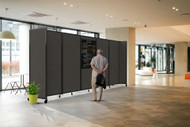How Room Dividers in Museums Improve Crowd Flow
Posted by Kate Murphy on Jul 31st 2025
From the cosmic wonders of a planetarium to the prehistoric tales of natural history, dazzling galleries of masterful art and cutting-edge digital exhibits, museums are vibrant stages where curiosity, learning, and inspiration come alive.
But as exhibits evolve and daily foot traffic enters, learning how to control crowds in a museum is key to creating a safe and engaging visitor experience. One often overlooked but highly versatile solution is the room divider.
Unlike fixed walls or traditional stanchions, portable partitions offer a flexible way to guide traffic, control noise, and adapt gallery layouts on the fly. Whether you’re prepping for a new exhibit, creating quiet zones for quiet reflection, or simply keeping foot traffic organized, the right dividers can help you shape the experience—literally.
The Challenge of Managing Crowd Flow in Museums
Creating a welcoming and accessible environment starts with one of the most foundational elements: visitor movement. The way people move through a space can significantly impact how they interact with exhibits, how long they stay, and how positively they remember their visit.
Unfortunately, overcrowding, congestion, and inefficient traffic patterns are common issues in museums—especially during peak hours, special events, or temporary exhibitions. Visitors often cluster in popular areas, while less-trafficked galleries go underutilized. Without clear pathways or visual cues, guests may feel lost or overwhelmed, detracting from the overall experience.
The physical layout of a museum, from exhibit placement to hallway width, plays a key role in guiding foot traffic. But reconfiguring permanent walls isn't always practical. That’s where room dividers come in.
Why Room Dividers Matter in Museum Settings
Modern room dividers have evolved far beyond the plain, utilitarian, and flimsy panels of the past. Today’s dividers are designed with both form and function in mind, blending into curated spaces while supporting the practical needs of daily museum operations.
Types of room dividers commonly used in museum environments include:
- Portable Dividers: Designed for mobility, these freestanding panels are lightweight and easy to move—perfect for adapting galleries or multipurpose rooms as needs change. Whether preparing for an evening lecture or redirecting foot traffic during a high-volume day, portable dividers offer instant flexibility without permanent alterations.
- Modular Panels: These interlocking systems let facilities create custom layouts—straight walls, corners, or enclosed areas—with ease. Perfect for temporary wings, educational zones, or pop-up installations, modular panels can be expanded, rearranged, or removed whenever needed.
- Folding Dividers: With hinged panels that collapse accordion-style, these dividers are perfect for facilities that need compact storage and fast setup. They’re especially useful for temporary exhibit expansions or events that require quick space transitions.
- Sound-Absorbing Panels: High foot traffic and open layouts can lead to excessive ambient noise. Acoustic room dividers help dampen sound, creating quieter, more focused environments—especially near interactive exhibits, audio displays, or performance areas.
Design is also a key consideration. Many dividers now come in elegant finishes or fabrics, neutral color palettes, or custom-printed panels that complement existing exhibits or decor. Custom-printed dividers can extend museum branding or showcase art and photography directly on the panels. Many modern room dividers are made from lightweight yet durable materials—like polycarbonate panels, tackable surfaces, and sturdy aluminum frames—and are built to last without scuffing floors or damaging walls.
One of the greatest benefits of room dividers over permanent walls is their adaptability. Museums are always changing—rotating exhibits, updating layouts, hosting events, and welcoming groups of all sizes. Room dividers allow spaces to be reshaped quickly and affordably, without the need for construction, permits, or delays.
And unlike fixed partitions, mobile and modular dividers can be moved or reconfigured within minutes. They serve multiple functions across departments, offering temporary privacy or effective museum crowd control as needed. When not in use, they store compactly, keeping spaces flexible and clutter-free. This versatility helps museums remain agile, responsive, and focused on visitor experience.
With so many options designed to meet diverse needs, finding the perfect room divider for your museum is easier than ever. Explore the full range of room dividers here.
How Partitions Are Used in Museums
Let’s discover the many ways room dividers can improve museum crowd flow and make a masterpiece of space management.
Optimizing Visitor Traffic Flow with Strategic Divider Placement
When used thoughtfully, room dividers can guide guests naturally through exhibits, reducing bottlenecks and improving pacing. By shaping the direction of foot traffic, dividers prevent crowding in front of popular installations and ensure visitors don’t miss key displays along the way.
Dividers also provide a sense of progression, helping people understand where one exhibit ends and another begins. This leads to better crowd flow, more intentional exploration, and less confusion in the museum.
Supporting Temporary and Rotating Exhibits
Most museums rotate exhibits regularly, whether showcasing new acquisitions or hosting special traveling shows. Room dividers offer a quick, cost-effective way to reconfigure galleries on demand.
They’re perfect for creating temporary exhibit zones, hiding areas under construction, or transforming large open halls into thematic spaces. With the right divider, a single gallery can become a completely different environment overnight.
Noise Control and Acoustic Benefits
Busy museums face a constant battle with unwanted noise. Conversations, footsteps, and multimedia exhibits can quickly create an overwhelming atmosphere.
That’s where sound-absorbing room dividers come into play. Acoustic panels made with high-density foam or fabric-covered cores help dampen sound and reduce echo, creating a calmer, more focused environment. This is especially important in areas with guided tours, video presentations, or hands-on learning zones.
Enhancing Safety and Emergency Protocols
Room dividers also contribute to safety. During large events or peak visitor days, dividers can create clearly marked exit routes, queueing areas, or emergency isolation zones.
Because they’re movable, they offer rapid-response flexibility in emergencies or crowd-control situations. They can also help segment space to reduce cross-traffic during health-related concerns or temporary closures.
Versare Room Dividers: A Trusted Solution for Museums
Versare products are trusted by museums, science centers, and cultural institutions nationwide. Customers include the Science Museum of Minnesota, Natural History Museum of Los Angeles County, Norman Rockwell Museum, Museum of Pop Culture, GRAMMY Museum, and the Brooklyn Museum, among others.
Our range of room dividers is crafted to meet the unique demands of museum environments and include features like top-tier acoustic performance, fire-safety, durability, and stylish design.
Top products for museums include:
- Room Divider 360® Folding Portable Partition: The Room Divider 360® offers a smart, stylish way to shape your museum space—whether you're creating temporary exhibits, guiding foot traffic, or reducing noise in open galleries. Choose from four panel options to suit your needs:
-
-
- Fabric panels are tackable, perfect for mounting signage, maps, or artwork.
- Polycarbonate is lightweight, impact-resistant, and easy to sanitize.
- SoundSorb™ acoustic panels absorb ambient noise (NRC rating up to 0.77).
- Woodgrain laminate delivers a polished, gallery-worthy look that’s durable.
-
- Hush Screen™ Portable Partition: This mobile screen offers sound-dampening benefits, a tackable fabric surface for signage or displays, and an optional polycarbonate window to let in light and maintain a sense of openness.
- QuickWall® Sliding and QuickWall® Folding Portable Partitions: The QuickWall® Sliding option is ideal for creating straight walkways or dividing larger exhibit areas, thanks to its smooth-gliding, telescoping hinge design. The QuickWall® Folding divider is better suited for tighter spaces or irregular layouts, offering flexible crowd control with its 360-degree hinges and accordion-style panels.
- EverBlock® Wall Kit: EverBlock® interlocking blocks are waterproof, chemical-resistant, easy to clean, and fire-rated. Reusable and fully reconfigurable, they're perfect for creating temporary or semi-permanent exhibit walls, interactive zones, or controlling visitor flow.
- EverPanel® Wall Kit: EverPanel® is ideal for creating immersive environments, defining exhibit zones, or building temporary rooms—offering the flexibility to reconfigure layouts without the cost or permanence of traditional construction. It also meets ASTM E84 Class C fire standards, making it a safe, practical solution for public museum spaces.
Smarter Space Management for Better Museum Experiences
Museums are lively hubs where history, creativity, and innovation come alive—welcoming visitors eager to explore and be inspired. To keep the exhibit experience magical— and not chaotic—you need to master crowd flow and curate adaptable spaces that guide every visitor with ease.
Luckily, with Versare room dividers, curators and facility managers can unlock every inch of space, effortlessly adapt to ever-changing exhibits, and craft visitor experiences that are as engaging as the collections themselves.
Ready to reimagine your exhibition spaces? Contact Versare today to make your museum a masterpiece of design and function.


